School District No. 74 (SD74) has received $366, 932 in new provincial funding to assist the district with the costs associated with transporting students.
The funding was announced in August, with districts around the province requested to submit proposals by the end of September. SD74 Board of Trustees co-chair Carmen Ranta confirmed with The Journal in August that the district would be exploring different ways to utilize the funding.
“We don’t charge for busing, as we’ve done a lot of research and made our busing as efficient as possible,” she said at the time. “And our budget is not pinched as much as some others, so we can sustain our busing. Charging would be a hardship for many families in our district. And I’ve heard loud and clear from other districts that they hate having to charge to retain transportation service.”
As reported in The Journal last week (“SD74 seeks more after school buses”, October 27), the district’s proposal centred around providing more after school bus runs, so that students who depend on the bus to get them to and from school, and who do not have an alternative transportation method, can take part in more extra-curricular activities.
“There’s currently no bus service for students staying late for these activities,” says Ranta, who is thrilled that the district’s proposal has been accepted. “Our plan is to focus on three different areas.”
One of these is after school activities for secondary students, with funding being allocated to busing so that more students can take part without worrying about how they will get home afterward, while another is ensuring that funding for the district’s hardship policy is maintained. The policy allows students who otherwise could not afford to do so to take part in activities where a fee is involved.
The third area where the new funding will be directed is curricular and extra-curricular activities for all students, including sports, class activities, and field trips.
“We know, from experience, that it’s difficult to ensure that students have a rich experience with these sorts of activities,” says Ranta.
“This will expand the ability of Gold Trail students to have a richer experience through school. It’s something that never really goes away, the challenge of providing new opportunities.”
